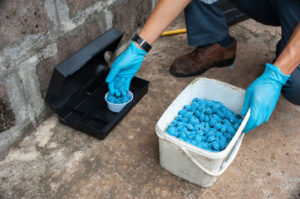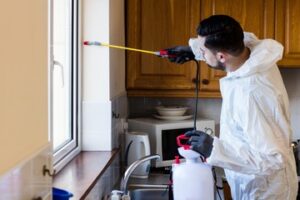Pests are unwanted creatures that can damage crops, food products and building structures. They can also cause contamination with disease causing bacteria like rotavirus, salmonella and streptococcus.
These pests include rodents like rats and mice, birds (pigeons, crows), cockroaches, ants and termites. Other organisms that can be considered pests are fleas, ticks and mites. Contact Seaside Pest Control now!

Accurate pest identification is the first step in developing an integrated pest management program. Without it, the wrong control tactics may be used and could cost time, money and potentially even harm to the environment. Proper identification allows you to determine the pest’s feeding habits, environmental and harborage requirements, life cycle and more.
Whether it’s an insect, weed, plant disease or vertebrate animal, accurate pest identification is critical to successful control strategies. This helps you to select cultural practices, tools, pesticides and other controls that target the specific organism at hand and minimize damage to your crop or to other plants and animals.
If you’re not sure what a particular pest is, your local Extension office or a specialized lab can help. They may require a sample of the pest or a photo to accurately diagnose it. Some specialized labs also charge for these services, so check with your local office before sending samples in.
A more convenient option is UF/IFAS’s Distance Diagnostic and Identification System, or DDIS. This process lets you submit digital images of the pests, weeds or diseases that are causing problems in your fields. DDIS is a powerful communication tool that provides a link between county Extension faculty, state specialists, clinic and laboratory diagnosticians and external experts.
The entomologists at MMPC’s Free Pest ID Center can analyze physical specimens of mystery pests or even photos of bug bites to provide accurate identification results and suggestions for treatment. You can visit the Pest ID Center at a MMPC retail store or contact the team using the form on this page to upload your photos for identification.
Species-specific identifications are important because different species may have similar appearances and behaviors, but they can differ significantly in their economic impacts. For example, chrysanthemum leafminers do not respond to the same insecticide products as beet armyworms. This is because different species are affected by the same common chemical compounds, but respond differently to other chemicals. The goal is to be as specific as possible when identifying pests. This can be done by examining the pest’s size, shape and color, as well as noticing other characteristics such as the location of the pest, the damage it is causing, and what food sources it feeds on.
Pest Prevention
Pest control is the set of practices and methods that are used to manage and reduce the risk posed by pests to humans, animals and property. It involves both proactive and reactive treatments, though it is generally easier to prevent infestations than it is to treat them once they have taken hold.
While pests may be present in all environments, they tend to be more of a problem in places where food is prepared and stored or where there are many people living in close proximity to each other. The presence of pests in such places can lead to contamination with disease causing bacteria, physical damage to the environment and to products made from it (e.g., rodent droppings or cockroaches), and irritation to people through direct contact with the pests themselves.
Preventing pest problems starts with learning about the specific pests and the options for their control. This includes knowing what they look like, where they tend to hang out and the signs of their activity (e.g., mud tubes in walls indicating termite activity or the faint sound of wood being eaten by ants). It also means practicing good hygiene – taking trash out regularly and using covered containers, storing food in airtight containers, removing weeds and reducing clutter where pests might hide.
Then there are mechanical and physical controls, which can include traps, screens, fences, radiation, heating, cold and electricity. These alter the environment, affecting pests by depriving them of water and food or changing the amount of light they receive. Sometimes the changes caused by these techniques are enough to eliminate a pest population.
Finally, there are biological control methods, which use natural enemies of a pest (predators, parasites or pathogens) to keep it in check. These methods often take a while to work and they do not achieve eradication of the pest population, but they can help to limit their impact.
Regardless of what method is used, it is important to follow the instructions for its application carefully to minimize the potential risks. For example, surface sprays should be applied only to areas that are not regularly touched by family members and should always be accompanied by a thorough cleaning. In addition, baits and traps should be placed in out-of-the-way areas where the pests live or travel, such as along skirting boards.
Pest Control Products
Many different types of chemicals are available for pest control. Some are synthetic, while others are derived from natural materials like plants, bacteria, and minerals. Natural sprays tend to be safer for non-target organisms (like humans and pets) than their synthetic counterparts, and they break down more quickly in the environment.
In addition, many of these products can be effective against a wide range of pests, which can reduce the number of treatments required. This can save both time and money for customers.
Some common pest control chemicals include cypermethrin, which is found in Demon WP and belongs to the pyrethroid chemical family; fipronil, which is found in Termidor SC and is a member of the phenylpyrazole chemical family; and bifenthrin, which is an ingredient in Yardley’s Permethrin insecticide. Several other chemical families are also used to kill and repel pests, such as organophosphates, carbamates, and neonicotinoids.
The type of product used depends on the pests being targeted and their habitats. For example, snap traps are a good choice for catching and killing rodents, while bait stations can be used to lure and kill insects like beetles and fleas. Physical barriers like fences and landscaping can also be used to deter pests from entering homes.
When using any pest control product, it’s important to read and follow the label instructions carefully. This includes information on how to store and dispose of the chemical, as well as the proper application techniques. For example, if a pest control spray is used around windows and doors, it should be applied as a coarse, low-pressure spray. It’s also a good idea to apply the product late in the day when most pests are at rest, and to thoroughly spray all crevices and cracks. Also, make sure to wear protective clothing and gloves when applying pest control products and to test any new sprays on a small, inconspicuous area before using them in the home. This will help ensure that the chemical is safe for use and will not stain or damage surfaces.
Pest Control Services
Pest control companies use a variety of methods to eliminate and prevent pest infestations. Services include inspections of buildings and properties, identifying pests, and applying treatments to kill or repel them. Some pest control companies also offer baits, traps, and other non-toxic options that are safer for people and pets. Pest control companies can also provide advice on how to avoid pests in the future.
Some of the most common pests that require professional help are rats, mice, cockroaches, termites, bed bugs, flies, bees, wasps, ticks, and spiders. Many of these pests can be harmful to humans because they spread disease or cause property damage. Some of them are also a nuisance because they bite or sting, leave droppings, cause staining, or smell.
There are several things that people can do to minimize the risk of pest infestation, such as practicing good sanitation and hygiene, storing food properly, and performing regular maintenance and cleaning of living spaces. However, it is important to note that these preventive measures are only effective if the problem is addressed immediately. For more serious problems, it is recommended that a person seek the help of a pest control specialist.
During a pest control inspection, a technician will identify the type of pest and its severity. They will then create a plan to remove the pests and prevent them from coming back. This may involve setting traps or using baits, but it is generally advisable to use only the most effective and safest pest control products. Pesticides should only be used when other less toxic options are not effective.
Pest control services can be used for both residential and commercial properties. Some companies specialize in rodent control, while others are more focused on insect infestations such as cockroaches and termites. In some cases, these companies can also help with wildlife infestations like raccoons and bats.
Standard Pest Management is a New York City pest control company that offers a wide range of solutions for residential and commercial clients. Their services include inspections of facilities, pest identification and treatment, preventing recurrence of pests, and providing educational materials on prevention and control. The company also offers service contracts for ongoing maintenance and inspections.

